Articles
Top 7 Biggest Ports in the UK: A Complete Guide
Introduction
Are you a UK-based entrepreneur with dreams of expanding your business globally? Or perhaps you're part of a multinational corporation that's interested in capitalising on the opportunities presented by the British market. Either way, you're in luck!
In this detailed article, we'll look at the seven biggest ports in the UK, providing invaluable insights into their importance, operations, and contributions to the nation's economy. This will empower you to make informed decisions and unlock new possibilities for your enterprise.
But that's not all.
As a bonus, we'll also discuss how Bezos's fulfilment services seamlessly integrate with these busy ports to streamline your logistics, ensuring smooth transportation of your products from dockyard to doorstep.
Understanding Britain’s Maritime Infrastructure
As an island nation, the United Kingdom comprises over 120 active harbours scattered along its coastline. [1] From major international terminals to niche regional centres, each plays an important role in shaping the country's complex trading environment.
However, it's worth noting that, according to Bloom, only the top 20 UK ports exert significant influence over the freight traffic landscape, accounting for almost 88% of the total trade volume. These dockyards handle a diverse range of imports, including oils and consumer products, while also facilitating the export of manufactured items and chemicals. Additionally, they cater to passenger ferries and cruise liners, bolstering Britain's reputation as a leading global travel destination.
In terms of operations, all the ports in the United Kingdom function under different models, with varying ownership and management structures, including a mix of private enterprises and municipal operations. Some follow a landlord system, while others engage in day-to-day activities. Importantly, regulatory oversight from entities such as the Department for Transport and the Maritime and Coastguard Agency ensures adherence to the highest safety and efficiency standards.
7 Largest UK Ports
Now that we've laid the groundwork for understanding Britain’s marine infrastructure, let's examine the specifics of the seven major ports that anchor the country's trade prowess.
- Port of Felixstowe
- Port of Southampton
- London Gateway Port
- Liverpool Port
- Immingham Port
- Dover Port
- Port of Milford Haven
1. Port of Felixstowe
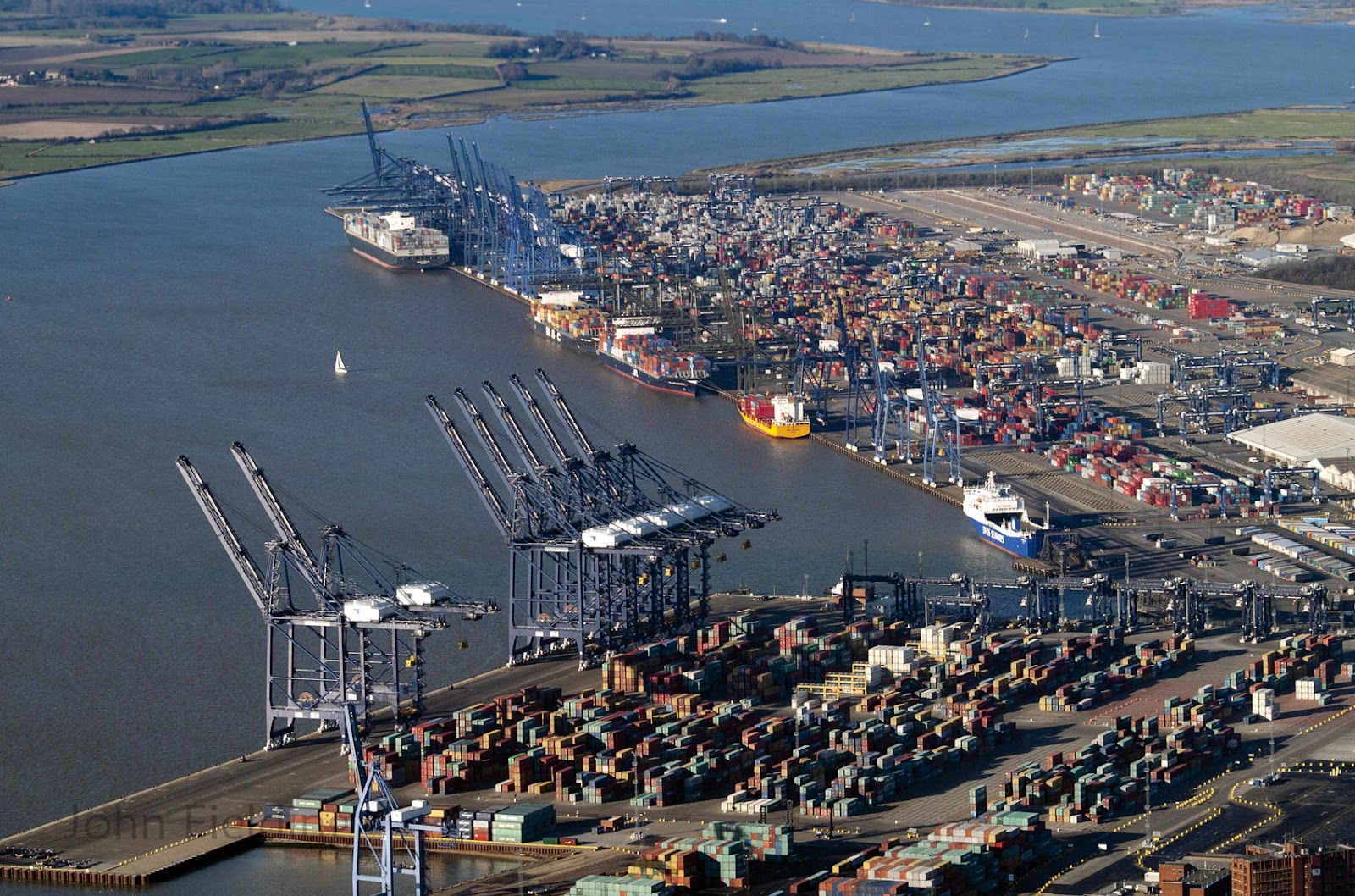
Tucked away in Suffolk, Felixstowe is the largest container terminal in the United Kingdom. [2] This port stands out for its large capacity, advanced facilities, and important role in boosting the country's maritime commerce.
With 17 deep-water berths spanning over 2.3 kilometres, Felixstowe is well-equipped to accommodate the largest vessels navigating the seas. This capability underscores its significance and its readiness for future trends in maritime logistics. Plus, every year, this dockyard handles over 4 million TEUs (Twenty-foot Equivalent Units), making it the busiest port in Britain.
Furthermore, the location boasts more than 30 ship-to-shore gantry cranes, some of the tallest in the world, capable of servicing ultra-large container ships from major operators. Its extensive storage and handling spaces ensure swift and safe movement of cargo, reflecting the port's strategic design for optimal logistical flow.
By using an advanced Terminal Operating System (TOS), the Port of Felixstowe utilises real-time data and GPS tracking to improve operations. This technological advancement enhances cargo management efficiency and significantly reduces vessel turnaround times. The port is also at the forefront of automation, employing automated stacking cranes and remote-controlled ship-to-shore cranes. These innovations increase both productivity and enhance safety by minimising manual intervention in hazardous areas.
In the coming years, Felixstowe plans substantial expansions to enhance its capacity and operational efficiency further. Among these initiatives is the introduction of a new berth, which will increase its ability to accommodate a greater number and size of ships simultaneously.
- Owned by: Hutchison Whampoa
- LOCODE: GBFXT
2. Port of Southampton
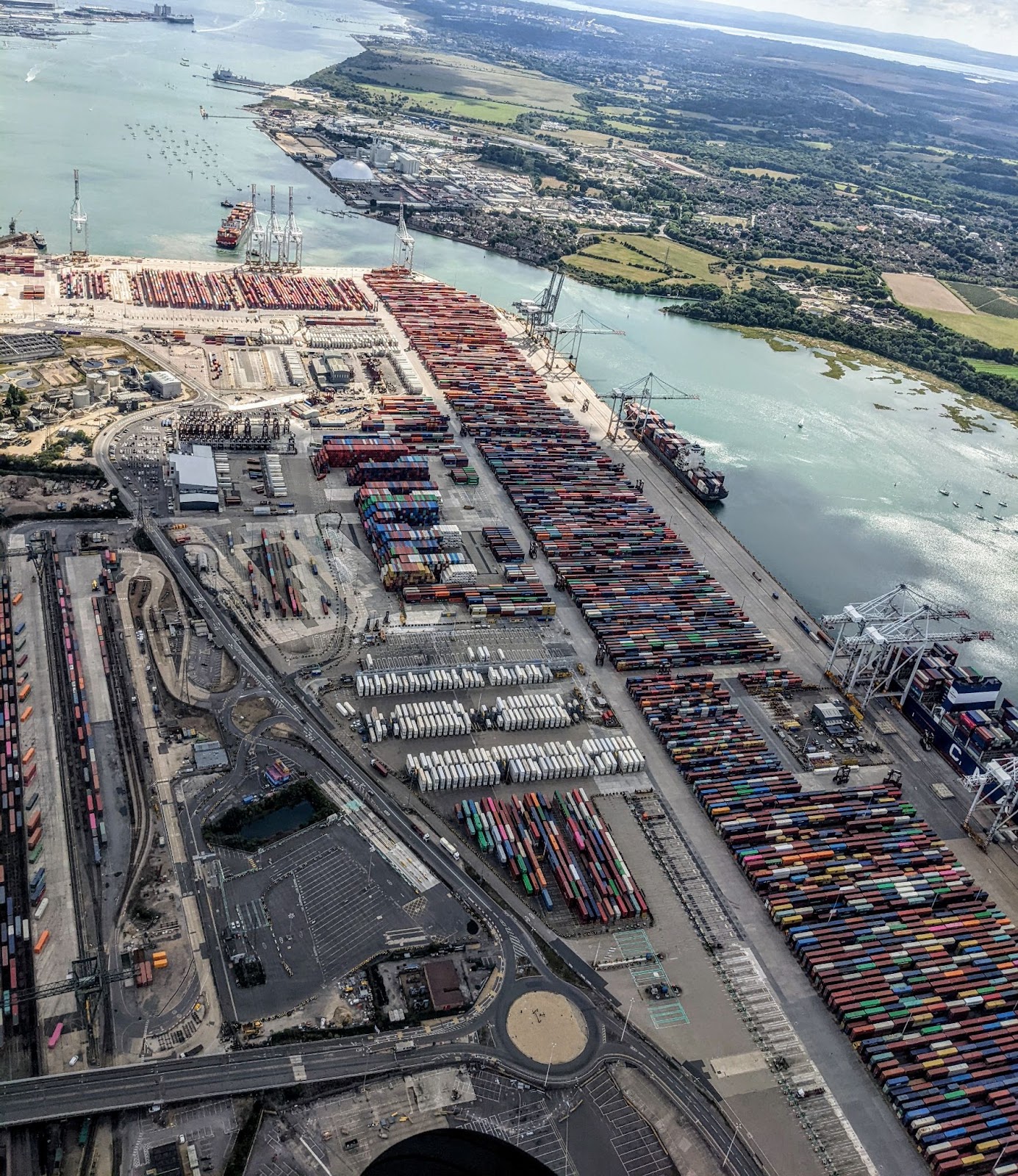
Renowned for its comprehensive operations, the Port of Southampton epitomises efficiency and versatility on England's southern coastline. Annually, it processes 2 million TEUs, demonstrating its impressive cargo handling capabilities. The container terminals are outfitted with deep-water berths and the latest in handling technology, ensuring cargo is processed with utmost speed and precision.
Beyond cargo, Southampton is a major cruise terminal, welcoming millions of passengers each year. [3] Its facilities are designed to support the world's most sizable cruise ships, providing a smooth transition for travellers and significantly enhancing the area's tourism and economic development.
The port is also a crucial node in the automotive logistics network, overseeing the import and export of countless vehicles. Its bespoke vehicle handling infrastructure, including layered parking solutions and specialised processing units, caters to the automotive industry's unique requirements, reinforcing Southampton's versatility.
Furthermore, its strategic placement near the English Channel positions Southampton as a gateway for international commerce, offering unrivalled access to global shipping lanes. This advantage is complemented by seamless connections to Britain's motorway and railway networks, ensuring distribution to domestic markets.
Other than this, emphasising sustainability, Southampton is also leading initiatives to reduce its environmental footprint. This includes adopting shore power technology to lessen emissions from docked cruise ships and promoting renewable energy use within its operations. Additionally, the port is committed to preserving natural habitats and promoting biodiversity, integrating waste management and recycling practices that highlight its dedication to environmental stewardship.
- Owned by: Associated British Ports
- LOCODE: GBSOU
3. London Gateway Port
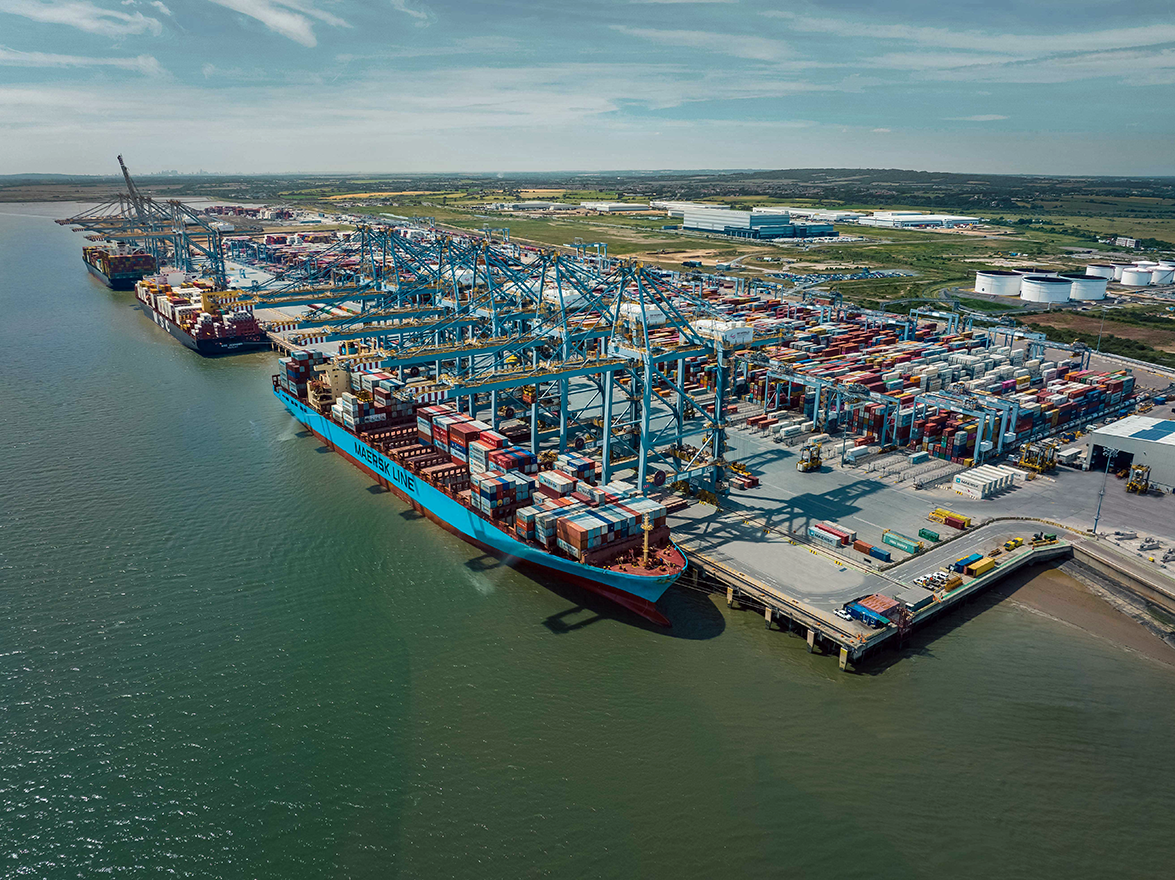
Another large port for importing products into the UK is London Gateway Port. Located on the River Thames' north bank, it marks a significant advancement in British port infrastructure, marrying innovative technology with smart planning.
Its strategic placement, a mere 25 miles from the heart of London, establishes it as an essential conduit for international commerce, especially for entities aiming for streamlined access to the capital and the broader southeast region. This proximity to the nation's largest market base also facilitates reduced transportation expenses and diminishes carbon footprints, which is in line with environmental sustainability objectives.
Moreover, London Gateway Port is tailored to accommodate the new breed of colossal container vessels, boosting its throughput capacity while ensuring it stays ahead in the logistics game. To this end, it is home to six deep-water berths spanning 2.7 kilometres.
This port also leverages sophisticated automation and intelligent technologies to optimise operations, ranging from cargo handling to seamless tracking of consignments. Innovations such as automated stacking cranes and GPS-driven vehicles further exemplify its commitment to operational efficiency and precision.
Furthermore, as a pivotal source of employment in the area, the port plays a vital role in stimulating job creation and fostering economic prosperity. Its associated logistics park, ranking among Europe's most extensive, provides unmatched opportunities for storage and distribution and draws a diverse array of enterprises and sectors.
With plans for further berth additions and expansion, London Gateway Port aims to scale its capabilities in tune with the dynamic needs of international commerce. This growth strategy reflects not merely an expansion in physical capacity but a reinforcement of London's prominence as a global trade nexus.
- Owned by: DP World
- LOCODE: GBLGP
4. Liverpool Port

Liverpool's maritime history is deeply intertwined with the growth of the British Empire, serving as a gateway for global trade since the 18th century. The port was a linchpin in transatlantic trade, particularly during the Industrial Revolution, facilitating the exchange of goods and contributing significantly to the city's prosperity.
The modern era has witnessed an extraordinary transformation of Liverpool, spearheaded by the Liverpool2 project. [4] This ambitious £400 million venture has introduced a state-of-the-art deep-water container terminal, dramatically increasing the port’s capacity to host the globe's most massive cargo ships. This upgrade, featuring enhanced quay walls, advanced ship-to-shore cranes, and the latest in container handling technology, signifies a bold stride into the future of maritime operations.
Named the most centrally placed port, Liverpool, like the ports mentioned above, also serves as a crucial logistical nexus, offering unrivalled access to the densely populated areas of Northern England, Scotland, and Ireland. Its extensive road and rail links ensure optimal distribution to key domestic markets, promoting economic vitality and regional growth.
However, the dynamic nature of global commerce, compounded by challenges such as Brexit and economic variances, demands constant evolution. To this end, Liverpool Port's strategy revolves around diversification and the adoption of cutting-edge technology to enhance competitiveness. Importantly, the port is not just advancing its digital infrastructure for smoother cargo handling but is also exploring green delivery practices to reduce its environmental footprint.
- Owned by: Peel Ports
- LOCODE: GBLIV
5. Immingham Port
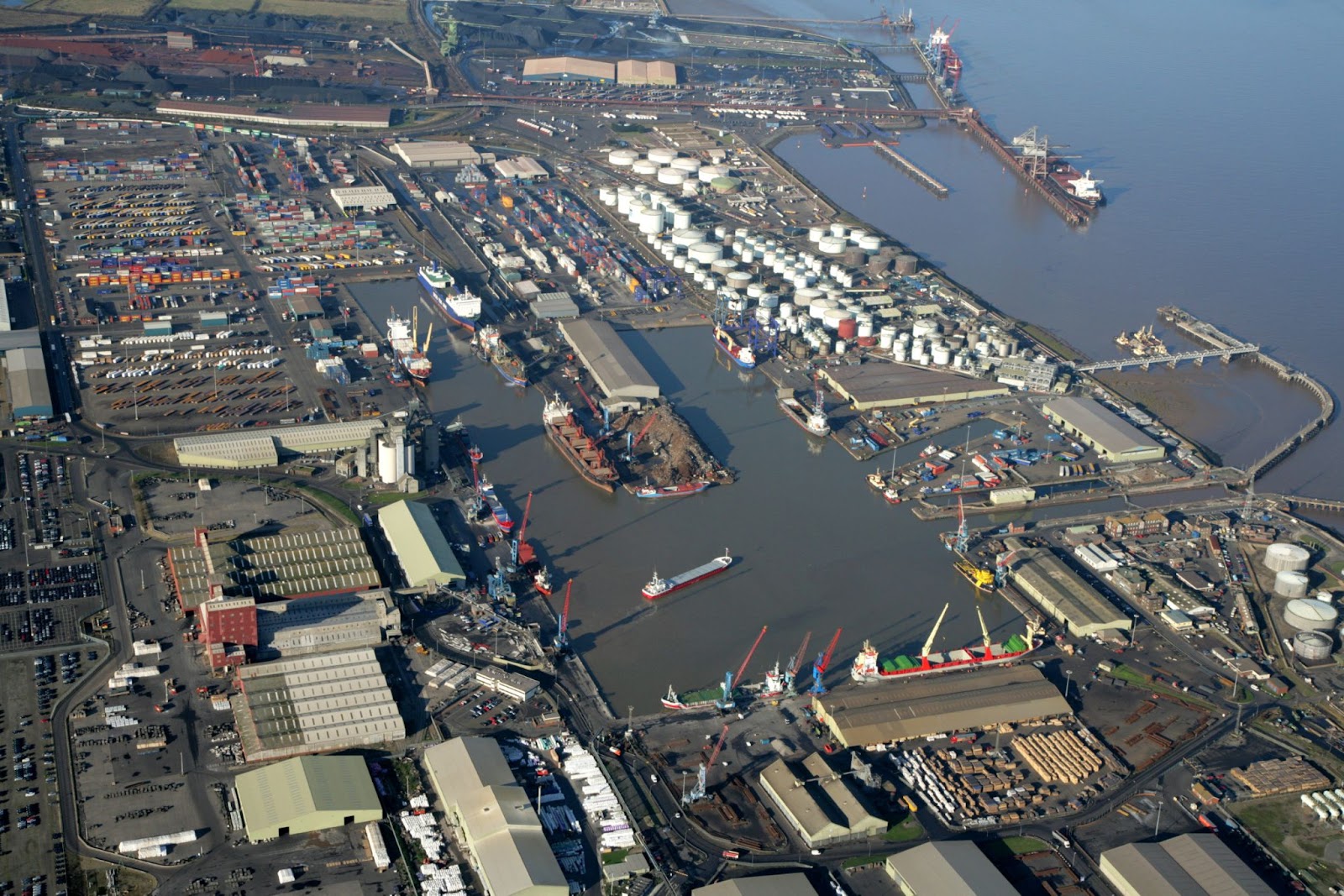
Opened in 1912, Immingham Port has grown to become one of the largest ports in Europe by tonnage. Its infrastructure is meticulously crafted to accommodate a diverse range of bulk materials such as coal, iron ore, petroleum products, and biomass. This specialisation positions it as an indispensable link in the supply chains of critical sectors, including the steel and energy industries.
Hence, perched on the Humber Estuary in Lincolnshire, Immingham stands as a pivotal entry point for essential raw materials needed in steel manufacturing. Furthermore, its major role in the petroleum sector, overseeing both imports and exports, directly influences the nation's energy supplies and pricing dynamics.
In addition to this, the port's strategic integration with Britain's internal transport networks, boasting superb road and rail connections, facilitates the swift movement of goods nationwide. This is vital for industries dependent on bulk commodities, ensuring a consistent material supply essential for uninterrupted production and maintaining a competitive edge in the marketplace.
Other than this, the Immingham Port is set on a path of continued progression and adaptation to the evolving demands of global trade. It is actively pursuing innovative technologies and operational methods to boost its efficiency and reduce its environmental footprint. Initiatives include investing in sustainable energy solutions and researching alternative, cleaner fuels for maritime logistics, highlighting its commitment to responsible operational excellence.
- Owned by: Associated British Ports
- LOCODE: GBIMM
6. Dover Port
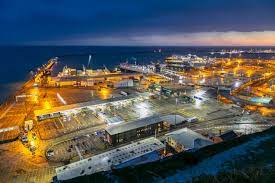
Dubbed the "Gateway to Europe," Dover Port embodies the United Kingdom's strong ties with the European continent. Renowned as one of the globe's busiest passenger ports, [5] it serves as a vital node in the trade and cultural interchange between the UK and EU, especially in terms of ferry services and cross-channel traffic.
For instance, the port's location, facing the narrowest part of the English Channel, makes it the closest UK port to France, with Calais about 21 miles away. This proximity has facilitated Dover's prominence in ferry operations, hosting millions of passengers, vehicles, and goods that traverse each year. Importantly, this role has been pivotal to its evolution into a major port, illustrating its important part in sustaining trade and mobility.
Furthermore, Dover's facilities include multiple berths designed to accommodate the latest and largest ferry vessels, state-of-the-art cargo terminals, and cruise ship terminals that welcome tourists from around the globe, adding a significant boost to the local economy and tourism sector.
Beyond its economic and logistical roles, Dover Port holds a special place in the heart of the community. It's a symbol of resilience, having played pivotal roles during historical events, including wartime operations. The port actively engages with the community, supporting local projects and educational initiatives that foster a sense of pride and ownership among residents.
- Owned by: Dover Harbour Board
- LOCODE: GBDOV
7. Milford Haven Port
.jpg)
Since its early days, Milford Haven Port has undergone significant evolution, shifting from an emphasis on coal and shipbuilding to a dominant role in the oil and gas industries. The transformation was particularly notable in the 20th century with the establishment of major oil refineries and natural gas terminals, which drastically altered both the local economy and the landscape.
Today, Milford Haven Port is known as the UK's largest energy port, and has a major role in powering the nation. In addition to this, it is renowned for its natural deep-water harbour, one of the deepest in the world, making it an ideal location for handling large vessels, including LNG (Liquefied Natural Gas) carriers, oil tankers, and bulk cargo ships. Its facilities cater to a wide range of industries, from oil refining and gas processing to renewable energy projects and marine leisure activities.
Hence, Milford Haven Port is an integral part of the UK's energy infrastructure, with two LNG terminals that are key components in the country's energy import capacity. The port's adaptability has also allowed it to embrace the shift towards renewable energy sources, supporting wind, wave, and biomass projects, reflecting its commitment to sustainability and innovation. Simply put, the port is not just a cornerstone of the Welsh economy but also a testament to the region's resilience and forward-looking approach to meeting the challenges of the 21st century.
- Owned by: Milford Haven Port Authority
- LOCODE: GBMHV
Summary Table: 7 Largest UK Ports
Bezos: Revolutionising eCommerce Logistics in the UK's Major Ports

Efficient and reliable logistics are the backbone of success, especially when dealing with the UK's major ports. Bezos, a full-service fulfilment provider, stands at the forefront of this revolution, offering unparalleled services to small and medium-sized eCommerce businesses. By integrating with the bustling activity of the UK's largest ports, we ensure your products move smoothly from dock to doorstep.
Whether you're a UK business scaling up operations or an Australian brand venturing into the UK and European markets, we offer tailored solutions that align with your unique needs. Our extensive network, including 63 fulfilment centres across 17 countries, ensures your products are stored, picked, packed, and dispatched with utmost efficiency, leveraging the strategic advantages of ports like Felixstowe, Southampton, and Liverpool.
Our AI-driven logistics system not only identifies and resolves issues before they impact your business but also saves you significant costs - up to £2 per order and 80% on international orders. With Bezos, you gain real-time visibility of your orders, inventory management across multiple locations, and an easy returns process, all through a single, intuitive portal.
By partnering with us, you're not just optimising logistics; you're enhancing your customer experience. Offer multiple delivery options and see your sales soar by 10-50%. Plus, with no long-term contracts or minimum volumes, you enjoy unparalleled flexibility to grow at your pace.
Get started with Bezos in less than 72 hours and see the difference. Speak to an expert today and start saving now.
Conclusion
In this piece, we’ve listed out the seven biggest UK ports, each with its unique strengths and specialisations that underpin the nation's trade and commerce. These ports collectively represent the dynamic and evolving nature of global maritime logistics.
Also, for businesses looking to leverage the strategic advantages of these ports, Bezos offers a seamless and efficient logistics solution. With our cutting-edge technology and expansive network, we ensure your products are handled with care and precision, from port to customer.
Get a free quote today and discover how Bezos can elevate your logistics experience.
References
- https://www.maritimeuk.org/about/our-sector/ports/
- https://www.studycountry.com/wiki/what-is-the-largest-port-city-in-england
- https://www.southamptoncruisecentre.com/southampton-cruise-terminals
- https://www.peelports.com/campaigns/liverpool2
- https://www.worldatlas.com/articles/the-busiest-international-ports-by-passenger-traffic-in-the-united-kingdom.html










